How Often Should You Wax Your Bowstring?
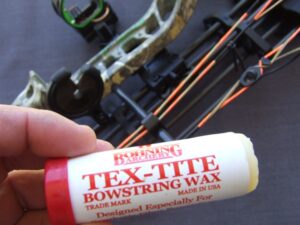
There are a lot of good bowstring materials available today that are extremely strong and robust, however, they do need to be maintained.
So, how often should you wax your bowstring? Some archers recommend to wax the bowstring every three weeks, but it will depend on how often you shoot your bow and the conditions. If you are shooting every day, than you could wax it once a fortnight. If shooting occasionally, than once a month will do.
Another consideration is not just how often you shoot in a week, but how many arrows you release in that session.
Depending on the enthusiasm or plan, a target archer may shoot sixty arrows once a week. Or release two hundred or more arrows a day, five to six days a week when practicing seriously.
A bowhunter may only release thirty arrows a few days a week when practicing. But the bow and bowstring might be used in harsh environments. So volume of use, conditions and frequency, need to be considered as well.
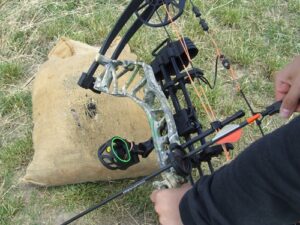
Here are some other reasons you should wax your bowstring.
If it starting to look fuzzy or dry, then wax it.
If it is predicting rain before an archery tournament than wax the bowstring.
If you are going bowhunting for several days in remote places, than wax it before you go.
Extreme weather conditions like: wet, hot, dusty, dry harsh environments, than you might even wax it every couple of days.
If you add a peep sight or replace it, give the bowstring a bit of love and wax it, before you insert the new peep sight in the string.
If you are going to reserve your center serving, remove the center serving, wax the bowstring strands and rub it before you put new center serving on. For more information on the correct fit for the arrow nock on the serving, click on, How tight should an arrow nock be?

Why should I wax my bowstring?
There is no sense having an expensive bow and arrows and neglecting your bowstring. The bowstring is what helps combine the performance of the limbs and is equally important with a compound bow, recurve or longbow.
By waxing the bowstring, it helps lubricate the individual bowstring strands, fibers and bundles.
When the bow is drawn back the individual strands and bundles stretch and move parallel to each other. The wax helps to reduce abrasion and protects them from dust, dirt and grime on and in the bowstring.
Waxing also helps prevent the string from absorbing water and making the bowstring heavier.
A water soaked bowstring can be very sluggish and reduce arrow speed, this then will affect accuracy. If you have every fired the bow in wet conditions with a soggy bowstring, you know that the string will spray water everywhere and the bows performance drops dramatically.
For very dry and hot conditions waxing helps prevent the material from drying out and deteriorating.
Waxing the bowstring also helps the bundles stay together when making bowstrings, like Flemish twist strings.
I have a compound bow, should I wax my string?
It doesn’t matter if you have a compound bow, recurve bow or longbow, you should wax your bowstring.
For a compound bow, wax the cables as well.
How do you wax a bowstring?
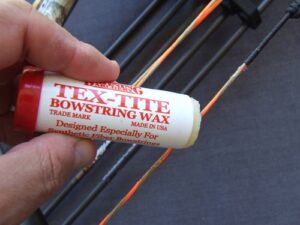
Apply the bowstring wax on the bowstring, trying to evenly coat it all the way around the diameter and from top to bottom of the string.
Rub the bowstring quickly up and down with your fingers.
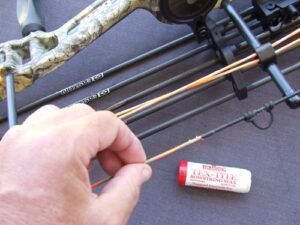
Rubbing with your fingers removes the excess wax and also helps coat the wax evenly all over the strands and bundles of the bowstring. It also heats up the wax and melts it in more, too penetrate in between the strands.
You can use a bit of soft leather, a strand of bowstring material or cordage to burnish the bowstring. Rub up and down the string to remove the excess wax off.
Make sure no excess globs of wax are left on the bowstring. Otherwise the extra weight of the wax can minutely effect the speed of the arrow and therefore accuracy of the bow.
How do you maintain bowstrings?
Just use the above steps of waxing your bowstring regularly.
Don’t leave the bow and bowstring in the open sun, as the UV rays are harmful. It can also fade some colors. (Never leave your bow in the car on a hot day.)
Keep an eye on the strings for frayed strands.
The cams on a compound can get bumped and create a sharp edge, this can fray the serving and bowstring. Check the cams haven’t got any sharp edges.
If your cables aren’t served covering the part where it slides up and down the cable guard, check for wear.
Be careful when knocking the arrow with broadheads as you can accidentally cut the bowstring.
When travelling along way, don’t leave broadheads on the arrows in the bow quiver in the case. The arrows might rattle out of the quiver and cut the string. Take the broadheads off and put them in a separate container.
Be careful attaching metal nock sets and d-loops to the bowstring. Click on How To Tie A D-Loop correctly for more information.
For nock sets and ways to set them up visit, Nock sets.
For longbow and recurve archers, use a bow stringer. This helps avoid dangerous stringing methods and will be easier on the bow, string and the archer.
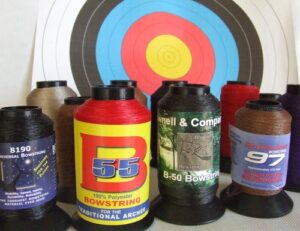
How often should I replace the bowstring?
The bowstring could be replaced every two years or more if the bowstring starts looking a bit worn. Some strings, depending on use and wear might last five years, ten years or longer with minimal use.
If you are target archer shooting every day, or bowhunting in extreme conditions were the bowstring can get damaged, then yearly would be a good idea to change it.
But inspect the string for wear, rather than just rely on age. If there are complete cut strands, replace the bowstring.
If in doubt, check the bowstring with an experienced archer who will be able to tell if it needs changing or not.
I did notice the new Bear Archery instruction manual states to change your strings and cables yearly. However, I think this is unnecessary if the string is fine. But if it shows signs of excessive wear than change it. (See my bow review on the Bear Legit Compound Bow Review.)
Can you use Chapstick or Vaseline to wax my bowstring?
The short answer is “No.” You don’t know what chemicals can affect the bowstring material and might prematurely damage it or weaken it.
Bowstring wax is cheap and will last a long time, so it is not worth mucking around with unproven chemicals that might be in Chapstick or petroleum jelly applicators.
Can I use beeswax to wax my bowstring?
Yes, you can use beeswax on bowstrings. Primitive bowstrings were likely coated with beeswax at one stage in history and is still fine today.
If you are a traditional archer and wants to keep to traditions, beeswax is a good choice. For deer sinew bowstrings and older bowstring materials like Dacron, beeswax is fine.
For modern compounds and modern recurves and longbows, the synthetic bowstring wax is formulated to work with the modern bowstring materials and might be a better choice.
Why is my bowstring fraying?
The bowstring (and cables) drying out can make it go fuzzy. Make sure you wax it.
Also abrasion can cause it to wear and start fraying it. This might be caused by having parts of a bow touching and abrading the bowstring. Such as a compound bow might have a bowstring that is not served where the string suppressor (or string stop) touches it when the string is released.
Cable slides can also cause wear on the cables.
You might have damaged the compound bowstring from trying to insert the peep sight into the bowstring. (Never use a bread knife to separate the strands to insert the peep sight.)
How do I know if my bowstring is bad?
If it is just some fuzz on the string, rub some wax on it.
If you see any cut strands replace the bowstring.
If the bowstring seems to be stretching (Not Dacron or string materials that do creep.) for an endless loop bowstring design, keep an eye on the string as it might mean a strand/s is cut or not tied properly.
If in doubt replace the string.
What is serving on a bow string?
The center serving helps protect the bowstring strands from repeated abrasion like using a finger release with an archery glove or finger tab.
Center serving also protects the bowstring from accessories like metal nock sets and d-loops attached to it.
Some bowstrings have serving on them in places were the string stop can contact the bowstring, or cable slide can rub the string.
End serving on the compound bowstring helps prevent it from wear in the cam tracks or groves.
The end serving on recurve and longbow bowstrings, protect the strands from the limb grooves and limb tips from repeated firing of the bow.
Do you wax the serving on a bowstring?
It doesn’t hurt if some bowstring wax gets on the serving. This also stops the serving from drying out.
For shooting in wet conditions I will wax the center serving and end serving on the bowstring.
For compound bow strings and cables, be careful that you don’t have too much wax on the end serving. As it might clog up in the cam grooves and dislodge the string off the cam tracks.
What happens if you dry fire a bow?
If you dry fire a bow (Release the bowstring with no arrow on the bowstring.) it can damage the bow.
The energy when released isn’t going into the arrow upon release, but has to go somewhere and the limbs and bowstring can get broken from a dry fire. Also cables and cams for compound bows can be damaged.
I have seen recurve bowstrings snap firsthand. Also I have seen the cables come off a compound bow when it was dry fired.
References, resources and extra information.
For information on draw length click on – How To Figure Out Your Draw Length and Correct Draw Length.
Visit, How To Measure A Bows Draw Length for details about the bows draw length.
BCY Fibers.
Brownell Archery.
Shooting the Stickbow by Anthony Camera
